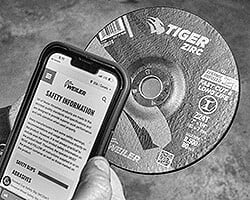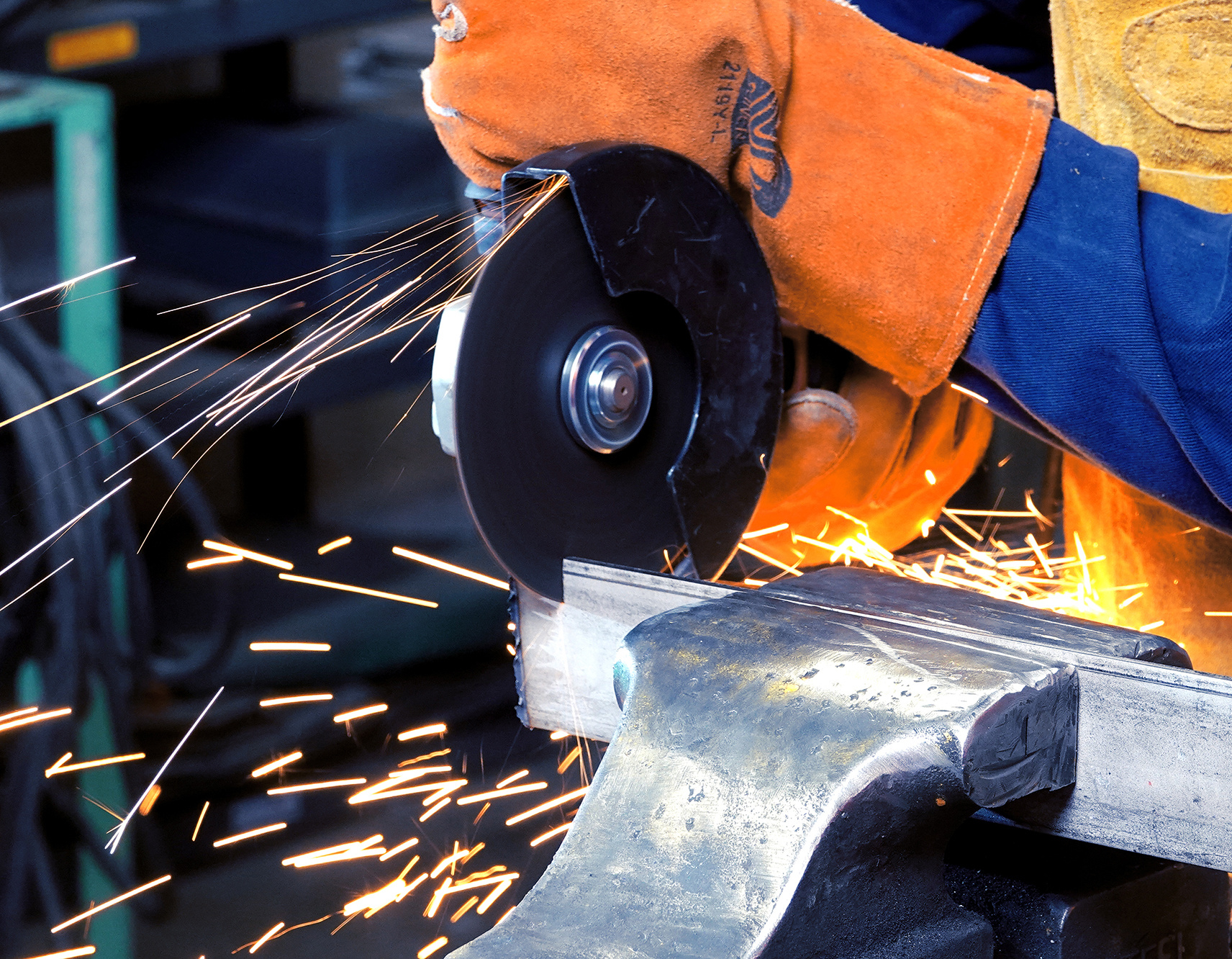Tips for Optimizing Productivity With Grinding Wheels

Tips for Optimizing Productivity With Grinding Wheels
By Tony Hufford, category manager – Metal Fabrication, Weiler Abrasives
Metal grinding is a demanding job. But it can be made easier by choosing the right product and the right tool for the specific application — and using them properly.
When an application calls for weld blending, bevel creation or heavy material removal to get a part to a certain dimension, portable grinding wheels are an efficient choice. However, getting the best performance out of grinding wheels requires attention to a few key factors. Learn more about grinding wheel options and get tips to optimize productivity when using these wheels in a manufacturing or fabrication application.
Benefits of portable grinding wheels
Portable grinding wheels, which are typically used on handheld right-angle grinders, provide versatility and portability since they can be taken to where the workpiece is. They are capable of removing a lot of material quickly. This helps operations focus on productivity and move on to the next job faster.
Type 27 grinding wheels, which have a flat grinding side profile with a depressed center, are the most common portable abrasive grinding wheels and are often 1/4-inch thick. Typically, when grinding wheels are designed to last longer, they cut slower, and vice versa. But there are grinding wheels on the market specially formulated to maintain speed while still delivering longer product life. This helps operations increase uptime and reduce wheel changeover, saving time and money.
Another common wheel choice for industrial applications is a Type 27 combination wheel in 1/8-inch thickness. Some combo wheels can be used for grinding, cutting and notching, making them extremely versatile.
Grinding wheel options
To choose the right grinding wheel, it’s important to consider the needs and requirements of the application, including the workpiece material, the tool being used and the desired result. There are many factors that can differ from wheel to wheel. Different abrasive grains, resin formulations, additives and fiberglass reinforcements all play a role in the results as well as wheel performance and life.
-
Grains: Consider some of the most common grain options. Aluminum oxide is an abrasive grain that is ideal for steel, iron and other metals in general purpose applications. While it provides fast initial cutting, this grain does dull over time and lacks the cut rate and potential longevity of some other grains. Ceramic alumina grains offer the benefits of self-sharpening and give a consistent performance over the life of the grain because as it breaks down, it constantly exposes sharp grain. Some options expose more sharp grain points due to micro-fracturing technology. They offer a long operating life under moderate pressure, and they are ideal for hard-to-grind metals such as titanium, Inconel or stainless steel. Silicon carbide is an extremely sharp and fast cutting grain that is also friable, so it’s not as tough as other grains. It tends to work best with softer materials like aluminum and is often used in products designed for stone, concrete or ductile iron. Zirconia alumina is a tough grain that offers self-sharpening capabilities under multiple types of applications, including those that require heavy pressure.
-
Fiberglass: The fiberglass in a wheel is the support that holds the product together. It provides reinforcement and rigidity and affects grinding ability. Fiberglass comes in different weaves and thicknesses. Look for combination wheels that offer triple layers of reinforced fiberglass, which gives additional support and strength for multiple applications and aggressive stock removal.
-
Bonds: The bond is the substance that causes the abrasive mixture to adhere and hold the abrasives’ intended shape. Bonds consist of different materials, including dry and wet resins and multiple additives. The bond on a grinding wheel may be hard or soft — or somewhere in between. A harder bond typically extends the wheel's lifespan, provided the user operates and maintains the wheel correctly. A softer bond allows for smoother grinding and exposes new grains more quickly. Choosing the correct bond for a given application and material can help balance performance and longevity while also increasing control and reducing chatter and operator fatigue.
Tips for improving productivity
Making the tough job of grinding as productive as possible comes down to several factors. Here are seven tips to help optimize grinding wheel productivity.
Tip 1: Choose tools carefully
Tool power makes a big difference in grinding wheel performance. If the tool doesn’t have enough power or torque, the operator won’t get the full performance of the wheel as its designed. For example, a product that contains ceramic alumina requires a higher-powered tool to ensure that the operator gets the full advantages of the self-sharpening grain. Even something that seems small, like the choice of extension cord, can affect wheel performance. Depending on the length, using a 10- or 12-gauge heavy duty extension cord versus a 16-gauge, for example, makes a difference in the performance of the wheel and also the heat that is generated in the cord. Always avoid stringing several cords together.
Tip 2: Start with a pull motion
With a new grinding wheel, start by using a pull motion for the first few strokes rather than a push motion. This helps break in the edge of the wheel, prevents initial gouging of the workpiece and familiarizes the operator with wheel performance. If the application allows it, use long, smooth movements and avoid short, choppy strokes. This gives consistent material removal in the work area and reduces the chance of digging into the workpiece, which can create costly rework.
Tip 3: Don’t dwell
It’s important to keep steady, consistent movements and avoid dwelling in the same spot when using a grinding wheel. Otherwise, heat will build up and could cause discoloration on high-value workpieces. Dwelling in the same spot can also result in removing too much material — potentially adding costly rework.
Tip 4: Use proper pressure and orientation
Operators may think that pressing harder will get the work done faster, but too much pressure on a grinding wheel can cause problems and increase operator fatigue. Use moderate pressure and let the wheel do the work. The orientation of the wheel to the workpiece also plays an important role in performance and productivity. The optimal angle for using a grinding wheel is typically 25 to 35 degrees. It can be used safely at a shallower or steeper angle depending on the application, but you will not achieve the same life or efficiency. Also note that not all 1/8-inch combination wheels are created equal. Some are specifically designed to cut and grind while others are for vertical use only. Make sure your technique matches the instructions on the wheel. If it says the wheel is for vertical use only, don’t use the wheel to grind on its face.
Tip 5: Optimize wheel life
Using a wheel for its full useable life helps operations reduce wheel costs as well as the downtime spent on changeover, which in turn helps improve uptime and productivity. Take advantage of technologies that help optimize wheel life. For example, new Tiger® 2.0 cutting, grinding and combo wheels from Weiler feature a patent pending Optimum Use Line — a visual indicator that helps operators use the wheel safely to its full life.
Tip 6: Keep a focus on safety
Some simple things to keep in mind include making sure the maximum rpm listed on the product is higher than the maximum rpm listed on the tool. Also, be sure the wheel fits under the tool guard that is installed on the grinder, and keep the guard on the grinder. Edge chipping or breaking can become a safety hazard if fragments fly off the wheel while it’s in use. The Tiger 2.0 wheel is formulated with anti-chip technology to extend wheel life and reduce the potential for edge chipping or breaking, allowing the wheel to wear down smoothly. In addition, QR codes on the wheels provide operators with instant access to safety information.
Tip 7: Consider the application
One of the first steps in choosing the right wheel for the application is to consider the job being done. Specific wheel designs and formulations are available for many applications and materials. For example, in multipass welding, grinding typically happens right after the root pass weld is completed, which means the weld can still be very hot. Look for a grinding wheel designed to break down on hot welds, which reduces wheel chatter and glazing. Foundry applications are also examples of very specific applications that require wheels designed for that work. Grinding in a foundry often involves working with hard-to-grind materials using powerful tools, so it requires a wheel that holds up to heavy pressure and higher torque to avoid premature edge breakage. Also, to avoid contaminating materials like aluminum and stainless steel during grinding, choose contaminant-free wheels designed specifically for those materials. Aluminum is a softer metal with a lower melting point than steel, so use a wheel specifically formulated to break down and not load up with aluminum material to maintain higher productivity.
Getting the most out of grinding wheels
Making a demanding job like grinding as safe, comfortable and productive as possible involves attention to several factors, including product selection, proper technique and the needs of the application. Following these best practices can help improve productivity with grinding wheels.
Republished from Welding Journal (September 2023) with permission from the American Welding Society (AWS). Click hereto view the original article.
